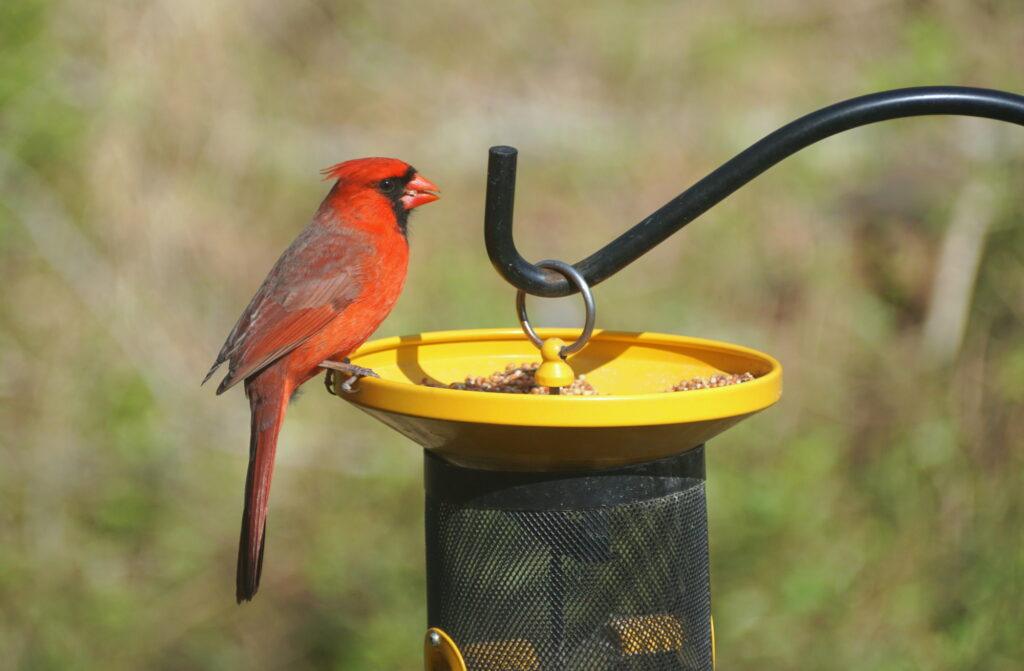Are you thinking of dedicating your next few birding sessions to cardinals? Just make sure you don’t accidentally drive them away with common cardinal bird feeding mistakes!
With their brilliant plumage and iconic song, it’s small wonder why so many birders want to attract cardinals to their yards. However, these birds have some unique needs that don’t always cross over with what other songbirds want.
When it comes to birding, honoring the unique little details of each species is much more effective than generalizing.
By the end of this list, you’ll be equipped with all the knowledge you need to make your backyard irresistible to various cardinal species. I’ll also recommend some products if you’re thinking of switching up your station.
Key Takeaways
- Cardinals are medium-sized birds, so you can’t use lightweight hanging feeders or perching feeders. Platforms and hoppers are the best options to keep them comfortable.
- Their diverse diet means you should switch between staples like black oil sunflower seeds with suet, berries, oats, corn, and peanut butter.
- Shaded, forested areas help cardinals feel safer. It’s also a good idea to install a bird bath and build a nesting site to make your feeding station extra appealing.
Use the Right Type of Feeder To Support Their Size
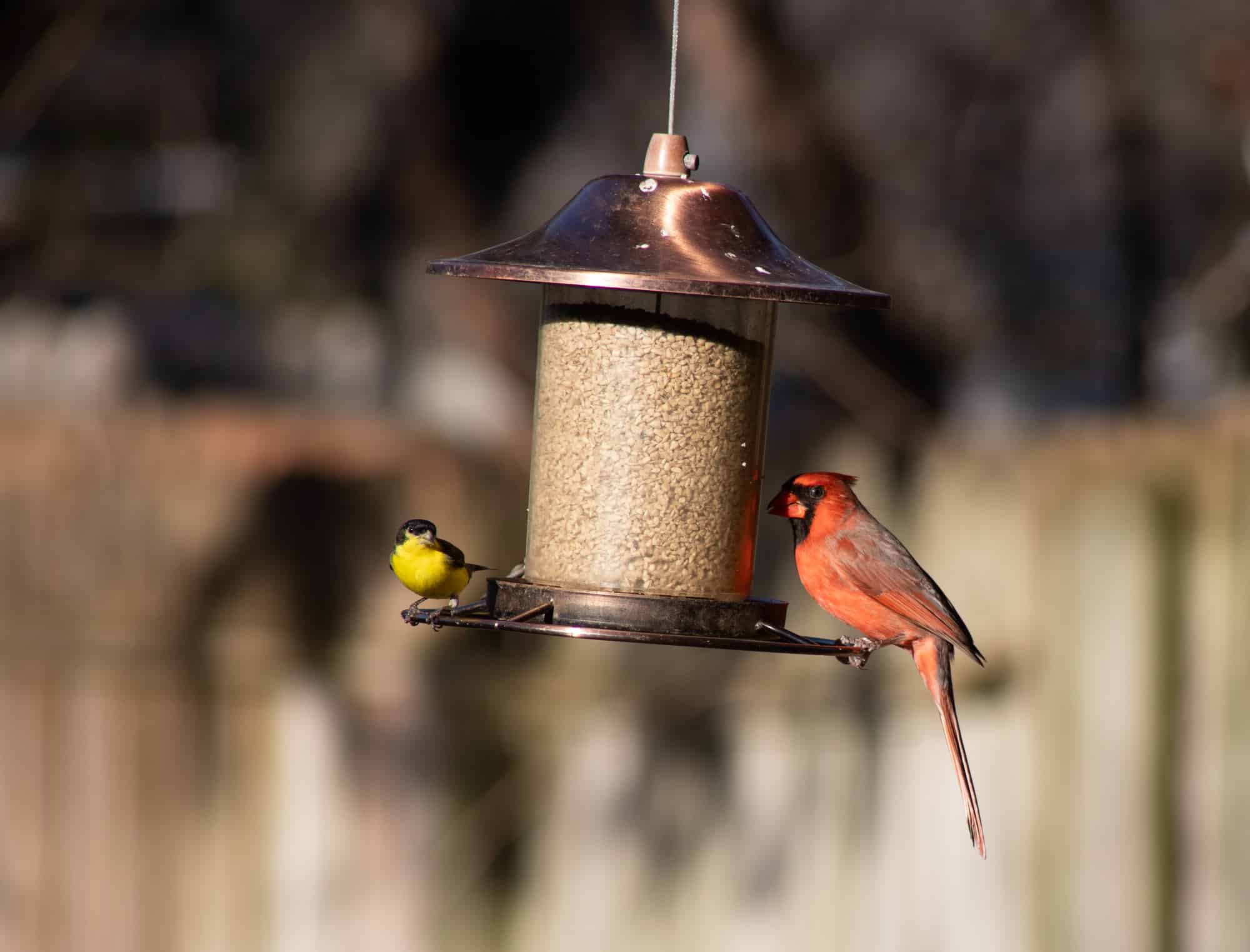
Thinking of reusing your sock feeders to bring cardinals to your backyard? Think again – these birds are a little larger than a sparrow or a warbler, so they need a specialized feeder to match.
The Northern Cardinal, for example, often ranges between 33 to 45 grams. However, larger individuals can hit as high as 65 grams, particularly when stocking up on their winter calories.
The desert cardinal is a little smaller, but can still clock in at 43 grams. When you consider that cardinals often like to feed in groups when it gets cold, you can’t rely on a lightweight feeder.
A common mistake birders make is thinking birds will eat just about anywhere. Different species can get picky and move elsewhere, so try the following feeders for cardinals:
Platform Feeders Are the Go-To Option for Cardinals
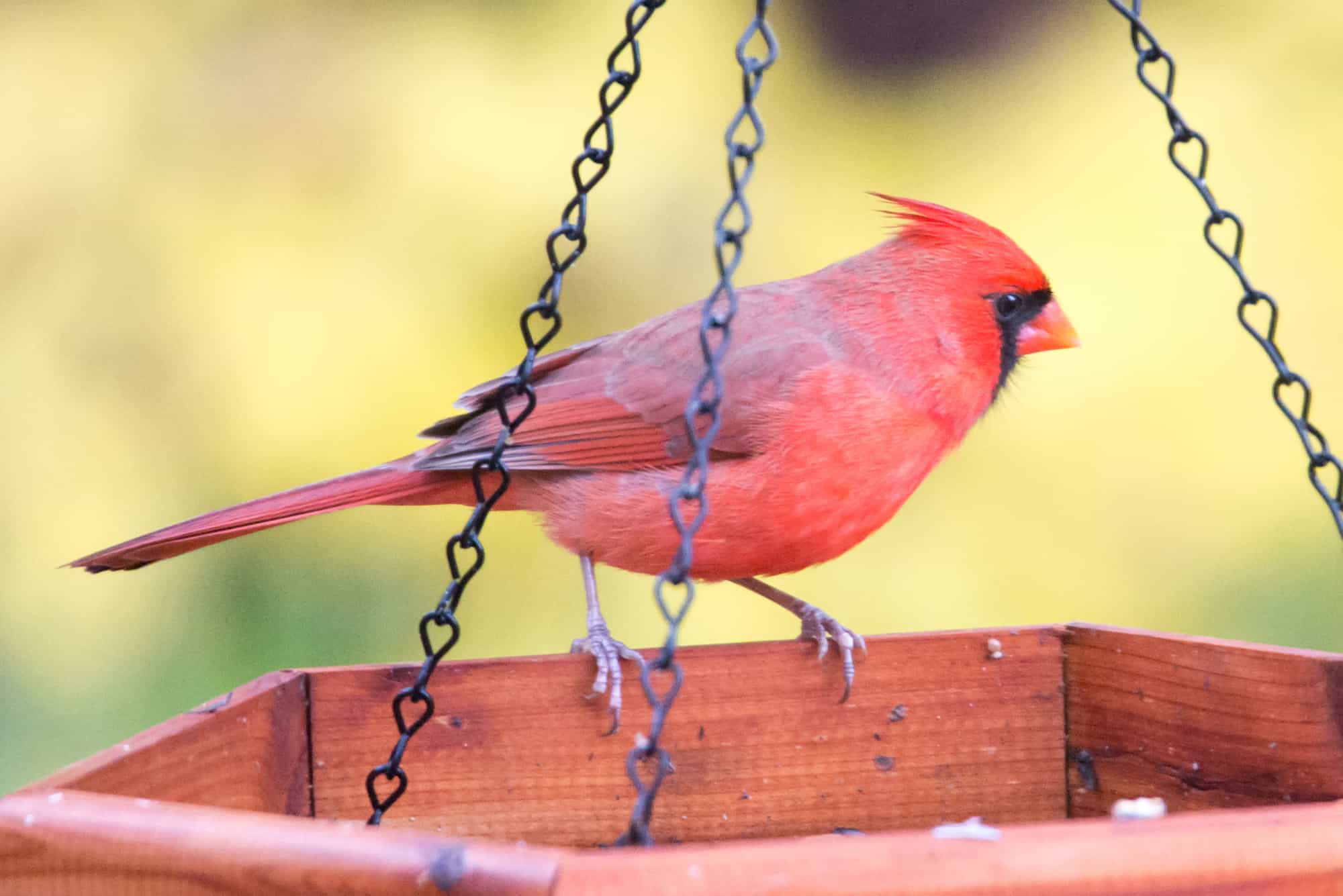
Also known as tray feeders, platform feeders are popular among cardinal fans since they easily support the weight of larger birds. Styled like a large tray, they give your feathered visitors plenty of room to forage without bumping into other birds.
If you need a starting point, consider the Kingsyard Platform Bird Feeder for Outside. This practical feeder gives you a little bit of everything in one place – plenty of space, recyclable materials, and a stable chain.
- ECO-STRONG: Made of durable recycled plastic and stainless metal mesh. Compare with normal plastic, recycled material can...
- GOOD BALANCE: 4 chains are more stable, it does not spin or tip when birds land on. And durable recycled material is heavy enough...
- EASY TO USE AND CLEAN: No need to install, easy to hang the bird feeder plate on a tree branch or a bird feeding station, and...
Last update on 2024-04-26 / Affiliate links / Images from Amazon Product Advertising API
This feeder can easily hold up to birds hopping around and landing on it without buckling. Its built-in drainage and air circulation features also keep feed from becoming wet over time, keeping it fresher for longer.
Hopper Feeders Are Often Sturdy Enough for Medium-Sized Birds
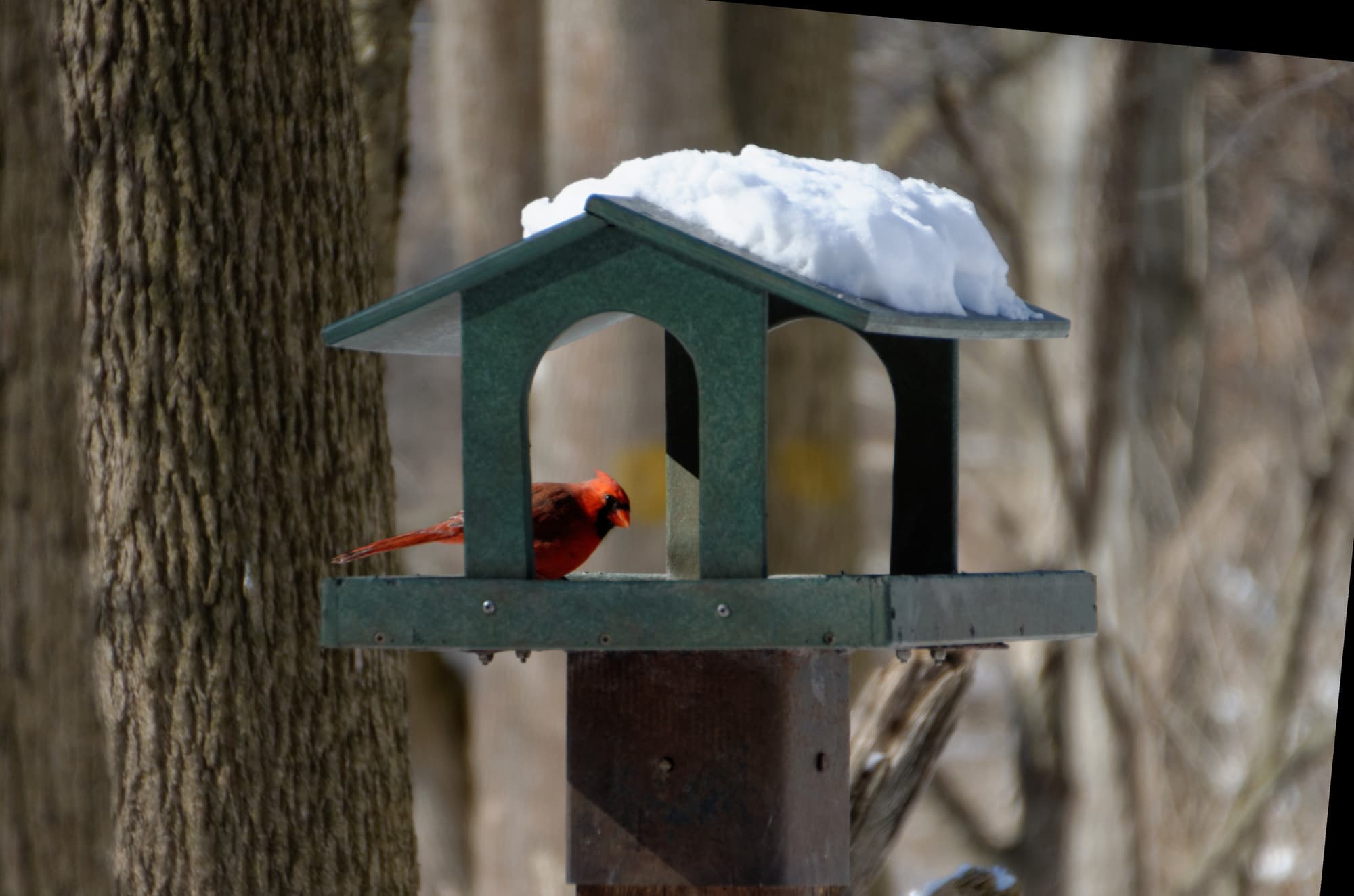
Do you live in a rainy area or want to keep leaves out of your birdseed? Hopper feeders are styled like a little house to give your hard-earned purchase more protection from the elements.
Cardinals will also appreciate the hopper feeder for feeling a little safer – this is a nice feature if your backyard or front yard doesn’t have many trees around. They’re very fond of cover, an element I’ll explore further below.
If you’re thinking of using a hopper feeder for your cardinals, consider the Jealoeur Bird Feeders for Outside. This is a beginner-friendly feeder with an easy filling port – just pop open the lid, fill, and close.
- 【JEALOEUR BIRD FEEDER】Jealoeur retractable bird feeders, can be expanded to store a large amount of food. It has a unique...
- 【SCENES TO BE USED】Press PUSH to open the lid, put the wild bird seeds, sunflower seeds for birds , safflower bird seed etc,...
- 【LARGE CAPACITY】It is made of durable, high quality plastic. Holds up to 2.2 Lb of seeds. Size: 8.7 x 7.6 x 7.8 inches.
Last update on 2024-04-26 / Affiliate links / Images from Amazon Product Advertising API
The plastic design ensures you won’t have to deal with mold, rust, or corrosion. The feeding port also naturally fills up the platform as the feed goes down, keeping you from refilling in between birding sessions.
If you want to learn more about the best cardinal bird feeders, we’ve got the list for you.
Stay Stocked up on Their Favorite Kinds of Food
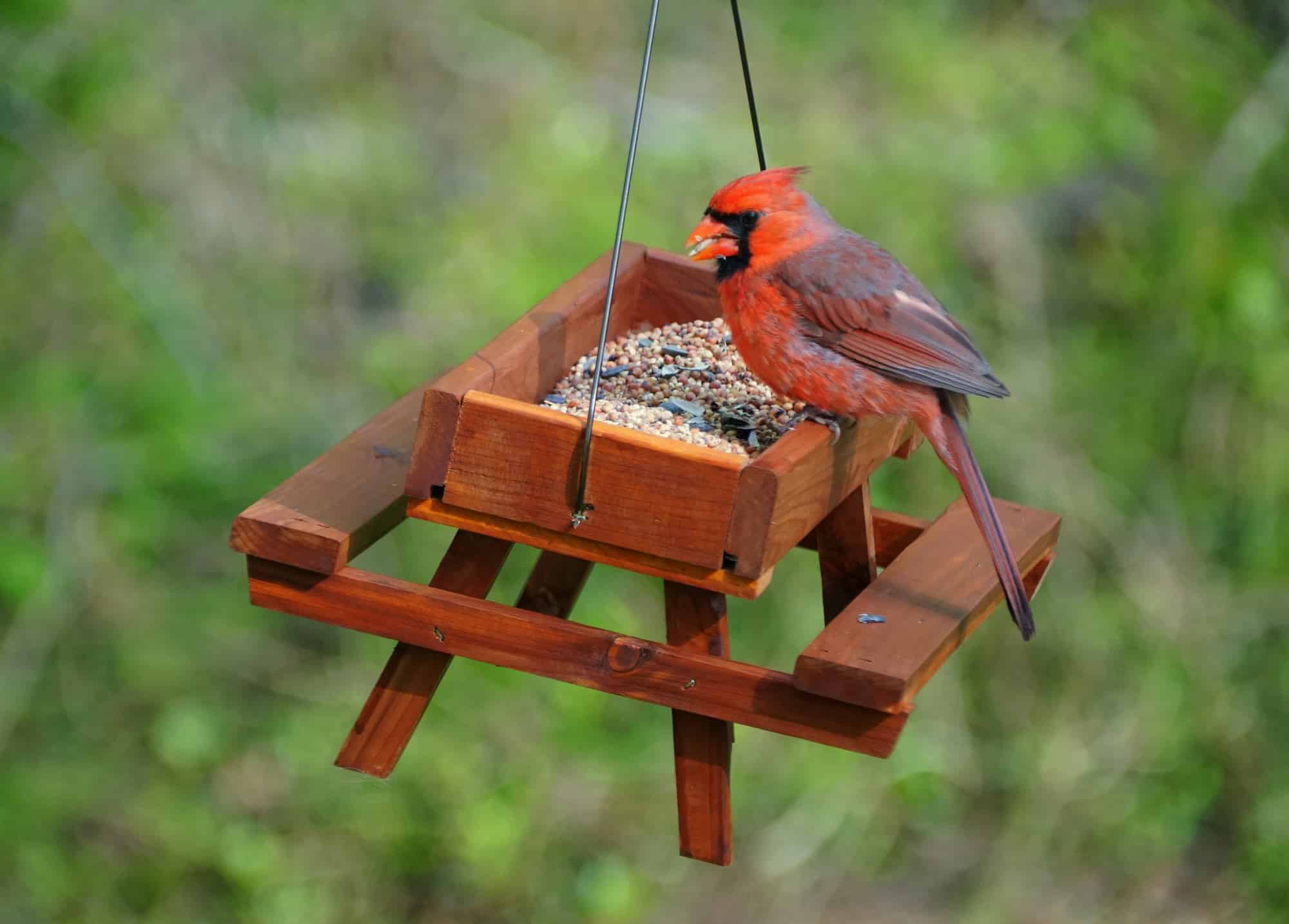
Cardinals are closely related to finches, sharing a thick beak well-suited to cracking open seeds. However, they have a rather diverse diet and even enjoy some foods humans often eat.
Below is a brief list of all their favorite kinds of foods, why they enjoy them, and which seasons suit certain feeds best.
Cardinals Love Black Oil Sunflower Seeds for Building up Fat
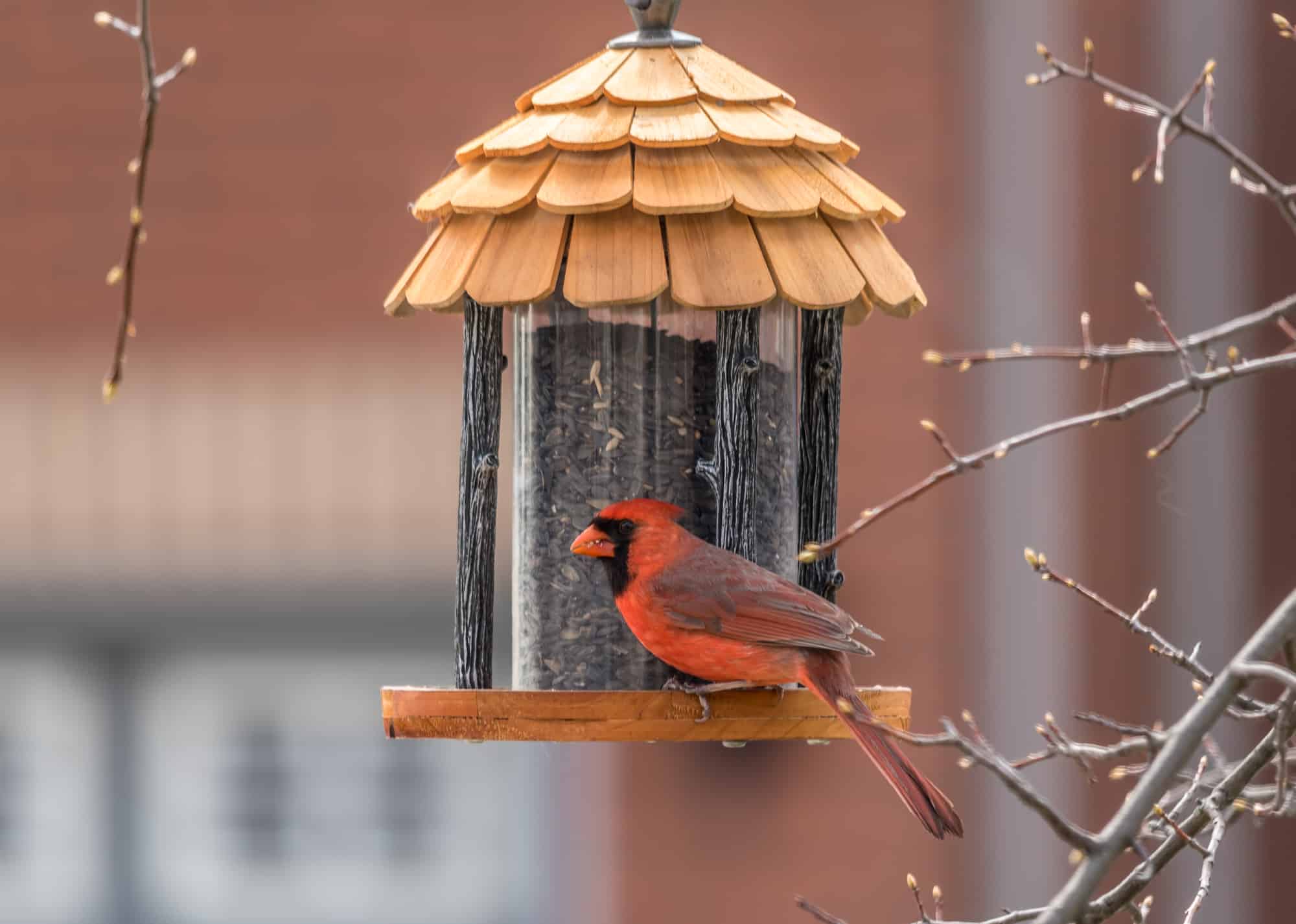
Why are black oil sunflower seeds such a popular addition for so many birds? They’re not only tasty, they have a high fat count that helps birds stay warm and energetic in the winter months.
Cardinals are no different, so make this seed one of your staple options. You don’t need to crack them open yourselves – their tough beaks are more than up to the task.
Just be mindful that they’ll leave a pretty big mess once they’re done!
These Charming Songbirds Often Eat Fresh, Ripe Berries
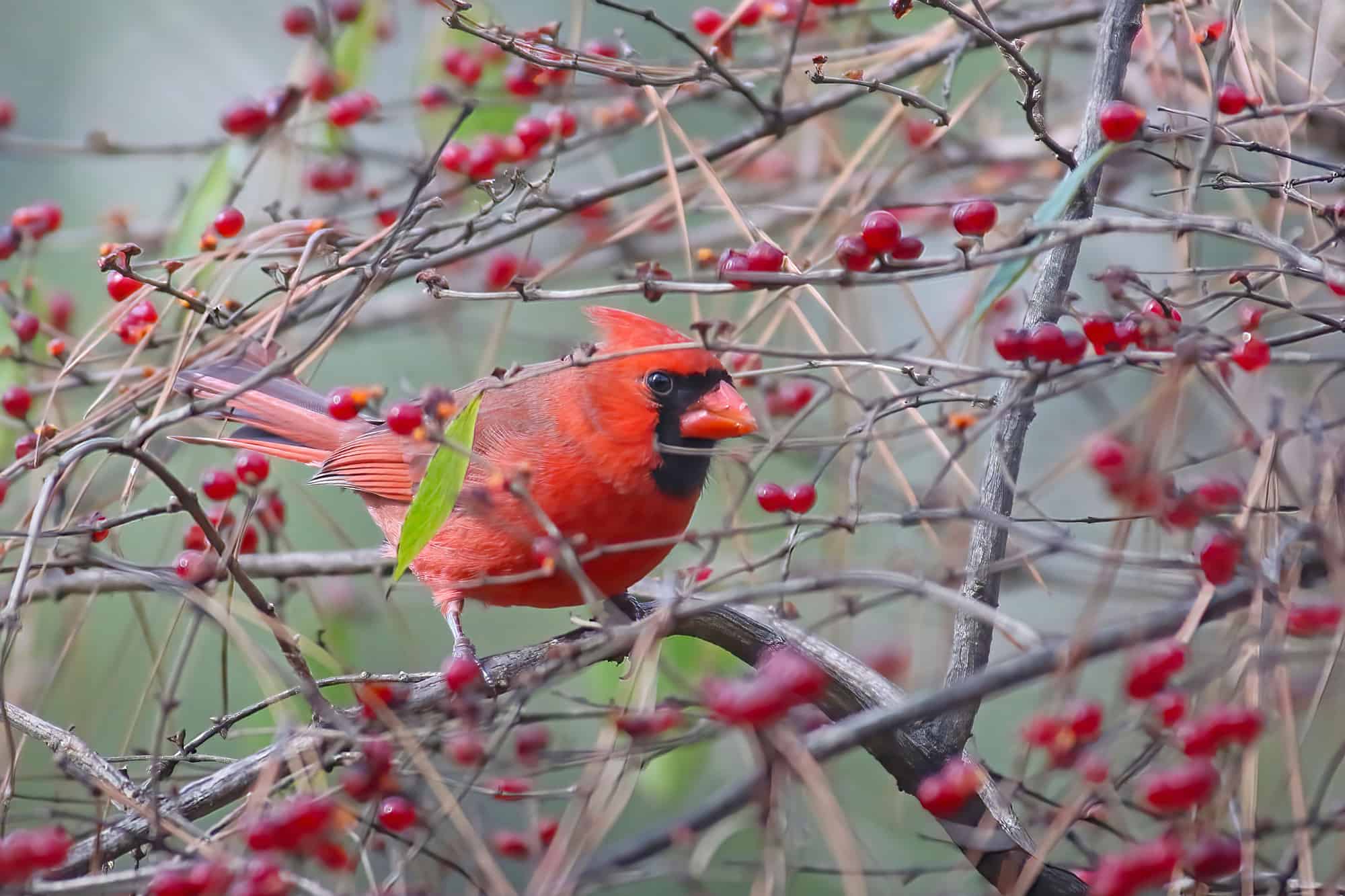
Cardinals, much like humans, like to shake up their meals from time to time. These beautiful birds will often eat fresh, ripe berries during the spring and summer months.
Berries not only have a high amount of antioxidants and vitamins, they also offer a little hydration. Just don’t place them out during the summer since they’ll spoil quickly – cooler weather like spring and fall will keep them fresher longer.
They’re particularly fond of blueberries and mulberries. If you want to go the extra mile to attract them, you can always plant a few of these bushes in your backyard.
Don’t Forget to Stock up on Smaller Seeds Like White Milo
Despite being able to eat larger seeds, cardinals are still fans of smaller varieties like white milo. This birdfeed is popular for its sweeter taste and impressive nutritional content – you’ll be keeping your cardinal friends quite healthy with this pick!
Just be mindful of spoilage. You’ll know white milo has gone bad when it does any of the following:
- Clumping together – this means mold is on the way
- Smelling sour or musty – this seed should smell a little nutty
- Any signs of insect activity like eggs or husks
Cardinals Enjoy a Little Peanut Butter, Oats, and Corn on the Side

One of the most enjoyable aspects of feeding cardinals is seeing how much they love popular foods humans eat. They’re big fans of delicious foods like whole oats, corn kernels, and even peanut butter!
Make sure to choose sugar-free peanut butter (many brands fill their jars with harmful high fructose corn syrup, which isn’t healthy for people or birds). Ensure your whole oats are free from moisture, too, to slow down spoilage.
You don’t need to cook corn, either. Cardinals have no trouble cracking corn open with their tough beaks.
Switch to Suet in the Winter To Keep Them Warm and Happy
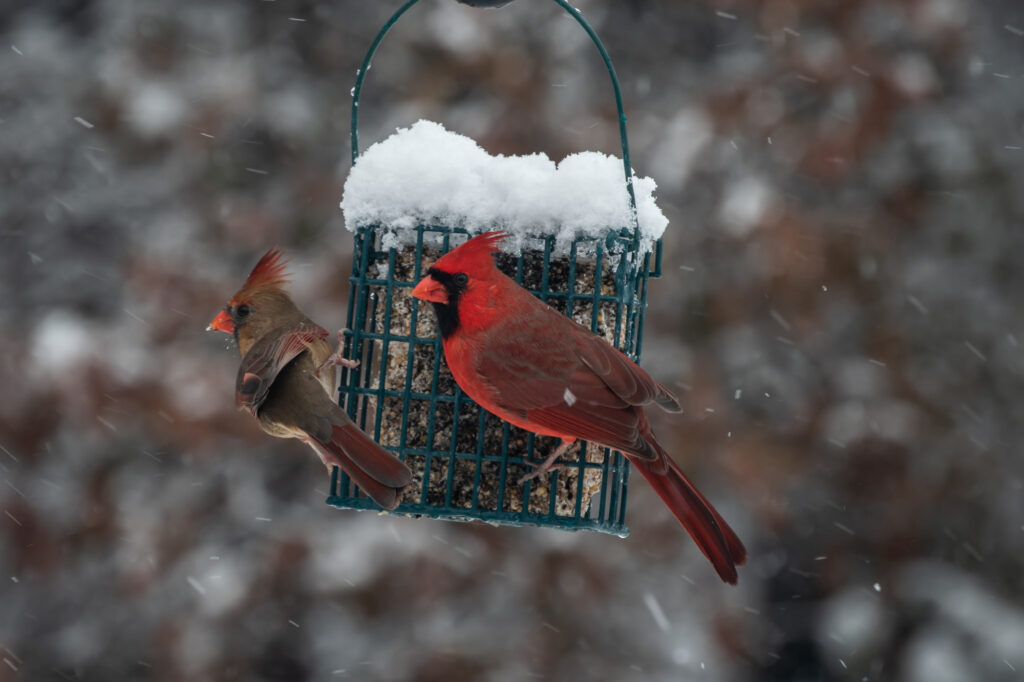
Once it gets cold, wild birds will be on the hunt for the most fatty foods to stay warm. A suet feeder gives cardinals easy access to chunks of fat for months on end, but you need the right feeder.
Suet feeders are designed with wire or mesh to keep squirrels away. However, birds will have no trouble latching on and dipping their beaks in for a few bites.
Since cardinals don’t usually perch to eat, consider the Kingsyard Double Suet Feeder. This larger bird feeder carries both birdseed and suet if you don’t want to get multiple feeders – however, there’s another important feature.
- ECO-STRONG: Made of durable recycled plastic. Compare with normal material, recycled plastic can withstand rain, snow and other...
- 360 DEGREE FEEDING: The suet cages and seed trays create a opening dining area that allows multiple birds to dine from every...
- LARGE CAPACITY: Holds up to 2 suet cakes and 3 lbs sunflower seeds or nyjer to attract a variety of perching and clinging birds...
Last update on 2024-04-26 / Affiliate links / Images from Amazon Product Advertising API
The style of the feeder makes it easy for cardinals to land on top and dip down for some suet.
A Regular Source of Water Will Help Immensely, Especially in Summer
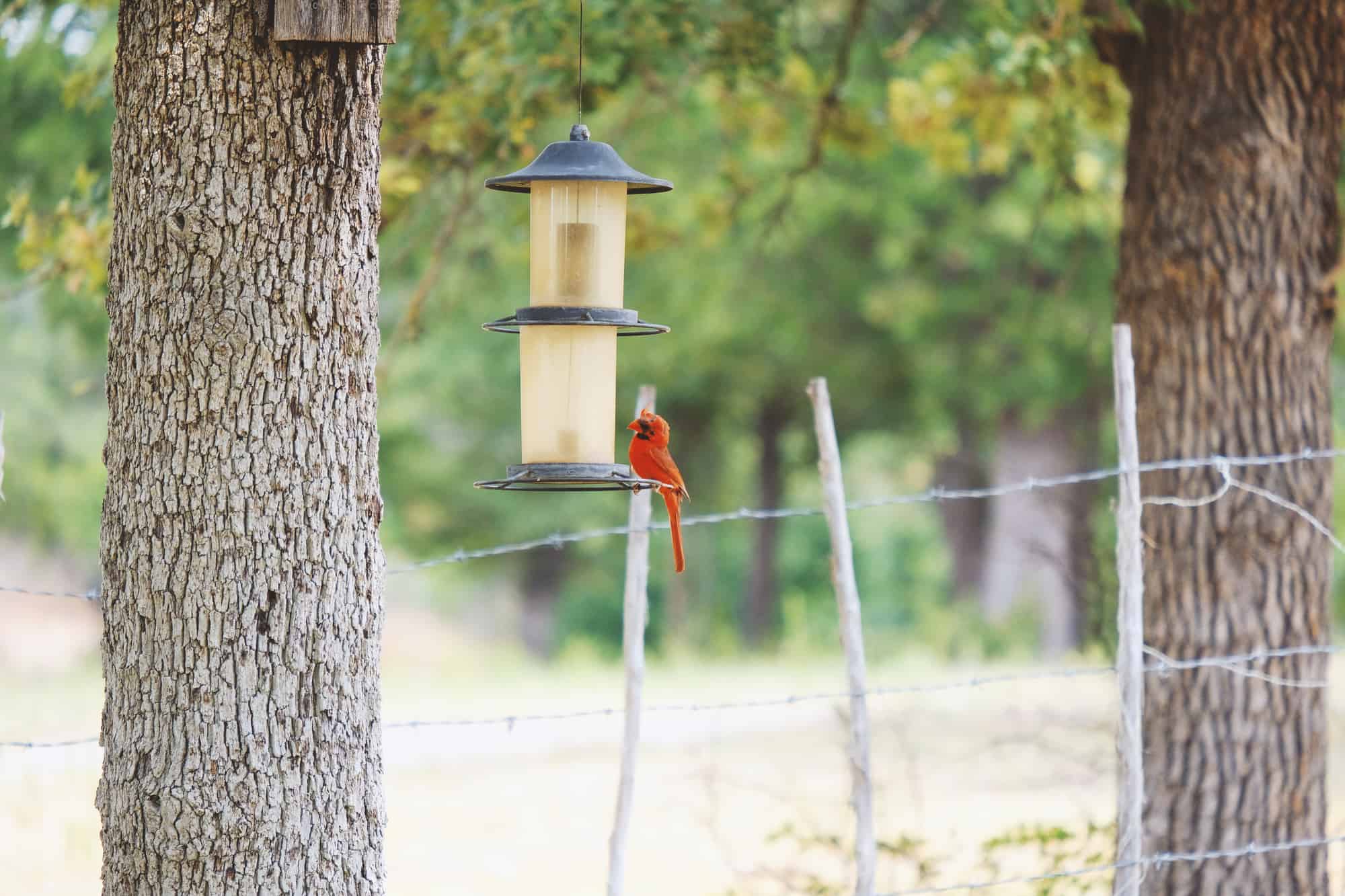
If you’ve been debating whether or not to get a bird bath, take this as your sign! Your cardinals will be extra happy if you help them stay cool during the summer months.
Birds need regular hydration and baths to keep them from overheating in the sweltering heat. Considering cardinals are a little larger than many songbirds, they’ll need a larger bird bath to match.
Wondering which birdbath would suit your set-up best? If you enjoy antique designs, consider VIVOHOME’s lightweight solution. It’s easy to set up and is resistant to common issues like cracking, molding, corrosion, and melting.
- AN ATTRACTIVE ADDITION - This birdbath is designed with an intimate European royal style with a bronzed patina and a hollow base...
- DURABLE DESIGN - Made of high-quality PP material and covered with resin coating, this birdbath resists rain, water, and other...
- STURDY BASE - Equipped with 3 ground stakes to keep it in place, it is not easy to tip over; For additional stability, you can...
Last update on 2024-04-26 / Affiliate links / Images from Amazon Product Advertising API
It also comes in several different colors like blue, brown, and silver, so you’ll have no trouble matching it with the rest of your bird feeding station.
If you don’t have a good place to set up a larger bird bath, I recommend checking out the Hanizi Bird Bath Deck Mounted Bowl instead. This bird bath is smaller and clamps onto your balcony railing so you can keep your cardinals cool.
- Garden birds need water for drinking and bathing just as much as they need food. Hanizi deck mounted birdbath will provide this...
- Hanizi birdbath bowl is sturdy and stable. Solid construction with premium quality finish, weather-resistant, prevent rust and...
- Easy installation and removal. No tools required. Deck mounted bird bath comes with an adjustable clamp that fits to decks up to 2...
Last update on 2024-04-26 / Affiliate links / Images from Amazon Product Advertising API
While it’s not big enough for large groups, it’ll still provide a cardinal or two a quick bath.
Place Your Feeder Somewhere Forested or Shrubby for Protection
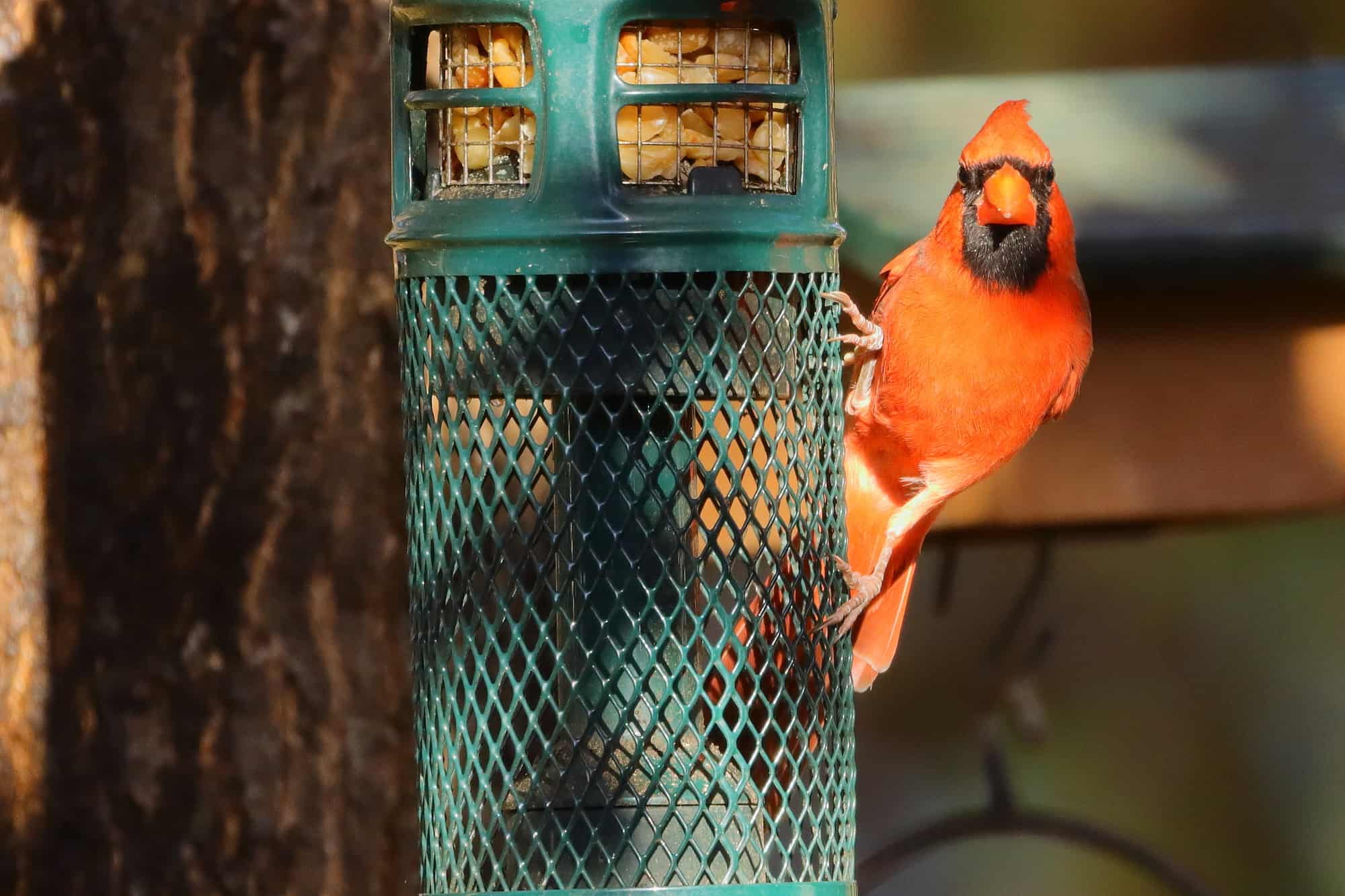
Cardinals feel much safer surrounded by trees and shrubbery. While they’re bold birds, they still need to duck for cover when predators are nearby.
A common mistake birders make when trying to attract cardinals is putting their feeder…well, anywhere! Simply sticking it in the middle of your backyard or in front of your house won’t entice them.
Try placing your feeder beneath a tree or next to a dense, shrubby area. If you don’t have many trees or shrubs, consider planting a few nearby – you’ll be amazed by how many more wild birds come to visit!
If you don’t want to go through the trouble of planting, you can also set up an outdoor sailcloth to create extra shade for birds. This also provides them with a more natural-feeling environment that feels less exposed.
Consider Creating Nesting Sites To Keep Cardinal Activity Active Year-Round
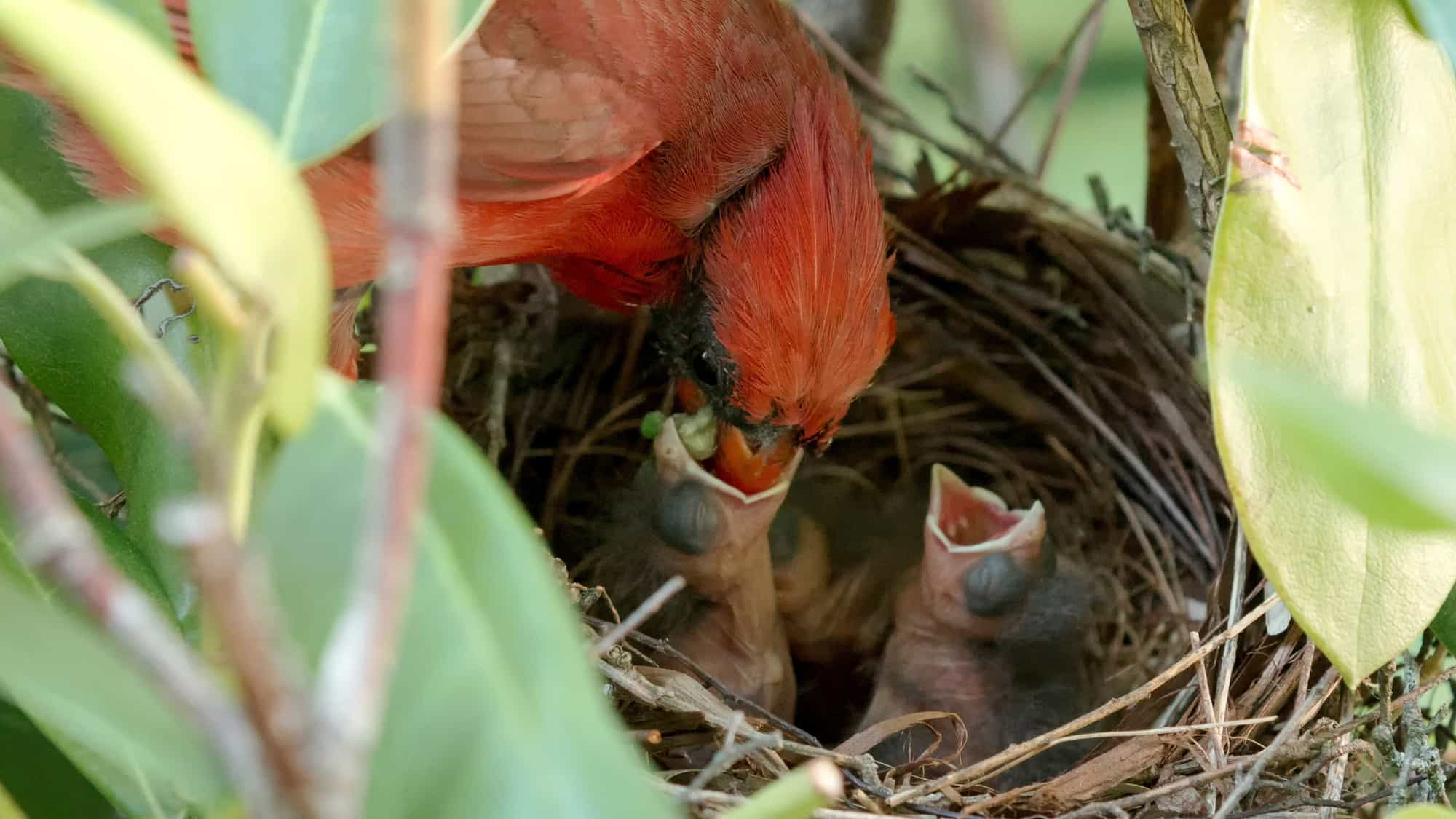
If you’re eager to see cardinals as often as possible, step things up by establishing nesting sites. Instead of going for a nest box, they prefer a dense and forested area to set up their nests.
Does that mean you have no work to do if you have an overgrown backyard? Far from it – you also need to make sure your nesting site has plenty of items for cardinals to use.
Some of their favorite ingredients for nest building include (but aren’t limited to):
- Twigs
- Pine needles
- Grass
- Leaves
- Bark
Frequently Asked Questions
Got a few more questions before you head out to your next birding session? Below are a few extra tips to increase your chances of enjoying your local bird population.
How High Off the Ground Should a Cardinal Feeder Be?
Not too high is your best bet – cardinals don’t feel safe in high, open spaces due to predators. Five to six feet is good, with no more than seven feet.
Where Should You Not Put a Bird Feeder?
Cardinals don’t enjoy bare, open spaces, so avoid the very middle of your backyard (unless you have some seriously dense tree coverage). You should also not put your feeder underneath thick, heavy branches since that’s where cats and squirrels like to perch.
How Long Does It Take for Birds To Notice a Feeder?
Birds sometimes take several days to a week before they start frequenting a feeder. Don’t feel disheartened if you’ve done everything on this list, yet see little activity – just be patient.
To avoid wasting food, use smaller amounts to start with.
Attracting Cardinals Is an Unforgettable Experience
Specializing in a specific bird species is a natural way to sharpen your birding skills. You allow yourself to hone in on the little details that make cardinals so special, which will go a long way to successfully attracting other species.
These round, charming birds prefer shaded, forested areas and enjoy a very diverse diet. They also like to bring their friends over, whether it’s a mate or a small flock in the winter months.
With a little love and care, you’ll have no trouble bringing them over to your feeding station regularly.
Want to sharpen your cardinal knowledge? You’ll love the following articles:

